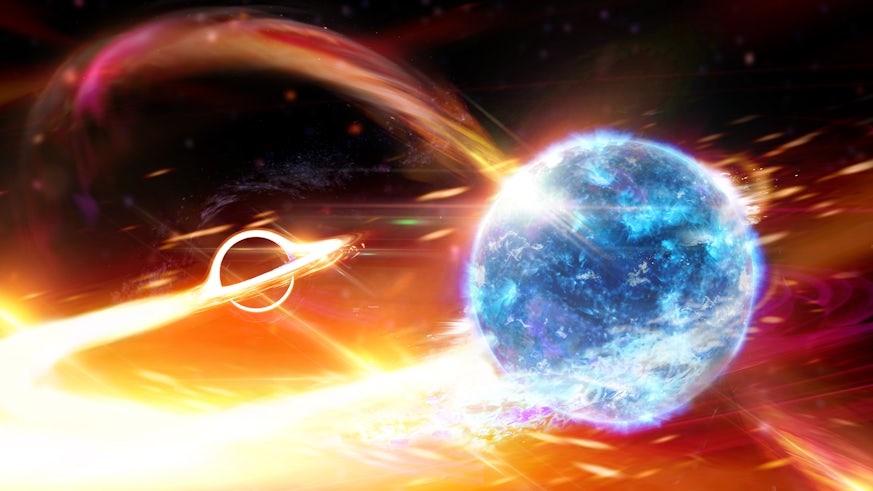Cardiff student at the centre of LIGO’s mysterious new discovery
23 June 2020

A Cardiff University student has found himself at the centre of a major breakthrough discovery that could potentially help to solve a decades-old mystery.
Charlie Hoy, currently in the third year of his PhD and a member of the Laser Interferometer Gravitational Wave Observatory (LIGO) Scientific Collaboration, has played a leading role in deciphering new data observed from the violent collision of two objects roughly 800 million light-years away from Earth.
In a new paper published today, the LIGO team describe a cosmic ‘face-off’ between two objects that circled each other before finally colliding and merging into a single black hole, generating a huge splash of gravitational waves that were emitted across the Universe and detected here on Earth.
The scientists are confident that one of the objects was itself a huge black hole roughly 23 times the mass of our sun, but they have been left stunned by the second object which appears to have been like nothing that has ever been detected before.
The size of the mysterious object lies in what scientists call the ‘mass gap’ and is thought to be something that is heavier than the heaviest known neutron star yet lighter than the lightest known black hole.
Up until now, scientists have not been able to find direct evidence of anything that lies within this mass gap.
The announcement is the latest in a line of spectacular discoveries whereby gravitational waves – tiny ripples that spread through space and time when two massive objects collide – have been detected on Earth and used to paint a picture of some of the biggest, most violent and unusual cosmic events happening across the Universe.
For Charlie, who has been working with LIGO as part of his PhD, the latest discovery left him in a state of astonishment.
“When I first saw the alert come through, my jaw hit the floor,” he said.
It was not until I saw the significance of this event that it hit me how important this event could be for astrophysicists around the world. This was the first possible detection of a highly significant neutron star-black hole candidate - something that we had previously never seen before.
Cardiff University has been a member of LIGO since its inception and has made key contributions to each of the individual detections of gravitational waves to date.
One aspect of the University’s Gravity Exploration Institute is the development of novel algorithms and software that have now become the standard search tools for detecting elusive gravitational wave signals.
The latest detection of gravitational waves, using sophisticated detectors in the US and Italy, actually took place on 14 August 2019.
Since then, Charlie has been a leading contributor to the ‘parameter estimation’ for this particular event on behalf of LIGO.
This involved untangling the gravitational wave signals and matching them with millions of possible combinations to determine the properties of the objects that produced the gravitational waves in the first place, such as their mass, the speed and direction at which they were spinning and their distance from Earth.

“Being a junior member of the collaboration responsible for a significant chunk of the analysis and helping to write the discovery paper has been a huge learning experience, and one that I am hugely grateful for being part of,” he said.
The gravitational waves emitted from this particular event, which has been dubbed GW190814, were believed to have come from the violent collision and merging of two objects to create a final black about 25 times the mass of the sun, roughly 800 million light-years from Earth.
The mysterious object is believed to have had a mass 2.6 times that of the sun, placing it firmly in the so-called ‘mass gap’, before it collided with a black hole that had a mass 23 times that of the sun.
"Whether any objects exist in the mass gap has been an ongoing mystery in astrophysics for decades," Charlie continued.
"What we still don't know is whether this object is the heaviest known neutron star or the lightest known black hole, but we do know that either way it breaks a record.
What is really exciting is that this is just the start. As the detectors get more and more sensitive, we will observe even more of these signals, and we will be able to pinpoint the populations of neutron stars and black holes in the universe.
Dr Vivien Raymond, a member of the LIGO team based at Cardiff University’s School of Physics and Astronomy, said: "With this new detection we keep pushing the boundaries of what we know about the population of neutron stars and black holes out there. This new event in particular involved joint efforts by many different international experts in the collaboration, and we are trying to get ready for the next surprise nature will reveal."
The new findings from the LIGO Scientific Collaboration and the European Virgo Collaboration have been published in The Astrophysical Journal. LIGO is funded in the UK by the Science and Technology Facilities Council (STFC).
Share this story
It is a friendly, approachable School with a strong commitment to teaching excellence and world class research in physics and astronomy.




